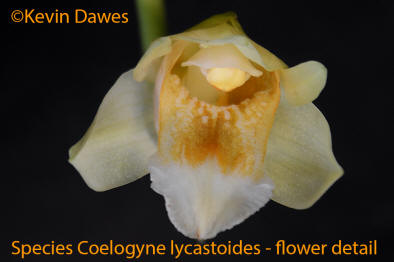Sometimes we just have to have a particular thing simply because we haven't got it and we want it - we still claim it is more mature than children screaming because they can't get a lolly! I think there is a confession that I must make. My conditions are totally unsuitable for this plant but I had to have it. There is no way that I can afford the tropical conditions that this plant requires. The point here is that if you don't have a reasonably close environment for any plant it will probably languish, grow and flower poorly and may even die. You don't really need it.
I tend to let my addiction over-ride logic. Rare, endangered and/or unusual plants should probably be catered for in botanical gardens, National Parks, etc. It may be better to specialise in the plants that do really well in your environment and concentrate on growing them to perfection.
My specimen is still small and it has taken several years to produce its first flowers. It is struggling a bit and I suspect that this is because it needs really tropical conditions.
Although I worked in Fiji for a number of years I was not aware that this Coelogyne existed there growing in lowland rainforest, and in its neighbouring Pacific Island countries. This is the eastern extremity of Coelogynes' distribution - quite an extreme from the Himalayas!
It belongs in the group of Coelogynes known as speciosae. This is a large, diverse group based on Coel speciosa but also includes fragrans, carinata, usitana, xyrekes and celebensis. Judging from pictures of Coel lycastoides it looks like the 'Ugly Duckling' of the group! Yet, it is named after the beautiful daughter of King Priam of Troy! If this was a lone flower found in a jungle I could appreciate it deserving a lot of admiration. It is nice but oh so easily lost in a crowd ( I think someone may have been doing a 'crawl' job to the boss when they named this one!).
It has been claimed that it can produce up to 5 almost simultaneously flowers but mine has struggled to get two open at once (in my colder conditions). The downward facing flowers are around 4cm long by 3cm wide - not big compared to the rest of its close relatives. The keels are unusual in that they are more like an undisciplined array of warts rather than the clearly defined rows normally observed.
Coelogyne lycastoides is often confused with Coelogyne macdonaldii. The former only has one leaf per psuedobulb whereas the latter has two leaves.
Negatives: .It requires a seriously tropical environment, i.e. a heated glasshouse.
Rating: ♦♦ If you have a lot of space and a hot environment you may derive a lot of pleasure from this Coelogyne from the furthest east of the Coelogyne distribution.
Varieties: None known
Hybrids: None registered
| < Coel longipes | Coel marmorata > |
